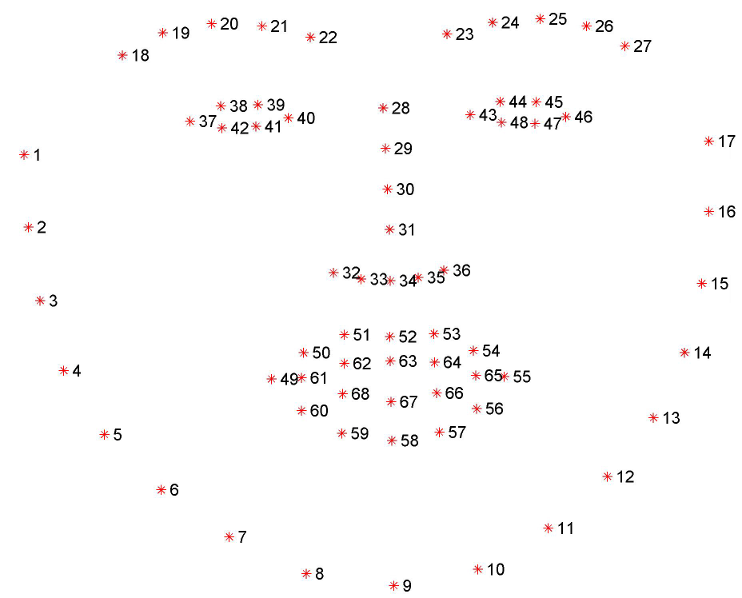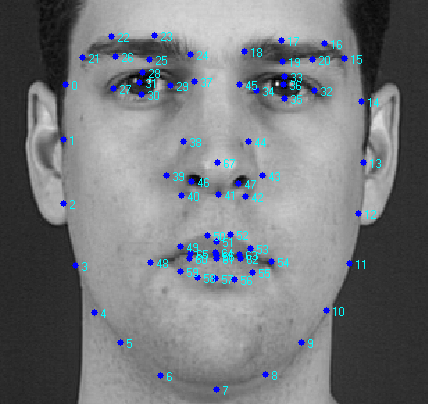Active Shape Modelling (ASM) and Active Appearance Modelling (AAM)
CS-160: Software Engineering
Instructor: Rob Bruce
Fall 2016
SLIDE 1: Active Shape Modelling
- Active Shape Modelling uses a pre-defined template with indexed points to define the outline of a surface.
- Active Shape Modelling is useful on faces to detect facial features such as the location of the eyes, nose, mouth, as well as the contour of the face.
- This technique was proposed by Tim Cootes and Chris Taylor in 1995.
SLIDE 2: Active Shape Modelling template
- Here is an active shape model template based on 68 data points. This template needs to be squashed or stretched before it will fit on a person's face.

Source: http://ibug.doc.ic.ac.uk/media/uploads/images/300-w/figure_1_68.jpg
SLIDE 3: Active Shape Modelling: applied to a person's face
- The Active Shape Model template with 68 data points is matched onto a real face:

Source: http://personalpages.manchester.ac.uk/staff/timothy.f.cootes/data/xm2vts/markup_large.png
SLIDE 4: Active Appearence Modelling
- Active Appearence Modelling (AAM) is an improvement over Active Shape Modelling.
- In AAM, texture on the face is used to compute how the template face should be squashed or stretched to fit the real user's face.
- The result is much improved tracking of faces when working with video (i.e. no jitter in index points).
SLIDE 5: Active Shape Modelling: training datasets
- In training, one could use the following dataset to train their own Active Shape Modelling system. The faces in this database contain annotated faces. See the web page at http://personalpages.manchester.ac.uk/staff/timothy.f.cootes/data/xm2vts/xm2vts_markup.html
SLIDE 6: For Further Reading
- Active Shape Models - Their Training and Application by T. F. Cootes, D. Cooper, C. J. Taylor, and J. Graham. This article is available electronically from the University of Manchester website at http://personalpages.manchester.ac.uk/staff/timothy.f.cootes/Papers/cootes_cviu95.pdf
- An Introduction to Active Shape Models by Tim Cootes. This article is available electronically from http://personalpages.manchester.ac.uk/staff/timothy.f.cootes/papers/asm_overview.pdf
- Active Appearence Models by T. F. Cootes, G. J. Edwards, and C. J. Taylor. This article is available electronically from https://www.cs.cmu.edu/~efros/courses/LBMV07/Papers/cootes-eccv-98.pdf
Robert Bruce
Research
Courses
Fall 2016, CS-160:
Lectures:
- What is software engineering?
- Postgres RDBMS (Relational Database Management System)
- Document management
- FFMPEG library and systems programming tools
- Project management
- Processing FORM data from an HTTP POST
- Requirement gathering
- High and low level design
- Secure session management with HTTP
- Programming the Postgres C API (Application Programmer Interface)
- Development
- Active Shape Modelling (ASM) and Active Appearance Modelling (AAM)
- Testing
- Eye pupil tracking
- Deployment, Metrics, and Maintenance
- Drawing with OpenCV
- Delaunay triangles
- Predictive models
- Iterative models
- RAD
Assignments:
- Programming Project 1
- Programming Project 2
- Programming Project 3
- Programming Project 4
- Programming Project 5
- Programming Project 6
- Final Project Oral Presentation
- Final Project Report
Handouts:
- Creating a bootable Linux Mint flash drive
- How to update software on Linux Mint
- How to install and configure the Apache web server on Linux Mint
- How to install and configure the Postgres database server on Linux Mint
- How to build and install Openface on Linux Mint
Programs:
- db_menu
- example_mkdir
- example_fork_exec_pipe
- example_draw_opencv
- example_draw_delaunay_triangles
- example_process_get_form_data
- example_process_post_form_data
